|
Michael McFadyen's Scuba Diving - Dee Why Ferry
One of the common fallacies about Sydney's Manly Ferries is the idea that they were all built in Great Britain and sailed out to Australia. In fact, the majority of the ferries were built in Sydney (eg Binngarra, Kuring-gai, Bellubera, North Head) and of the larger ships only the last three (including the greatest of them all, the SS South Steyne) were built overseas.
On 25 August 1927 in the Sydney Morning Herald, the Port Jackson and Manly Steamship Company announced that two new identical steam ferries would be purchased for the Manly run. They were to be called the Curl Curl and Dee Why (named after northern Sydney suburbs) and were to be built by Napier and Miller Ltd at Old Kilpatrick, Glasgow, Scotland.
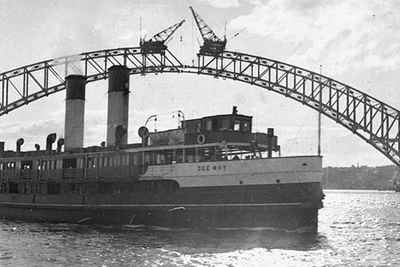 |  |
The Dee Why ferry passing the
uncompleted Sydney Harbour Bridge | Another shot of the Dee Why
Photo courtesy of Tom Binns |
The Dee Why was launched on 27 February 1928 and was 220 feet long and almost 36 feet wide. She had a main deck that stretched almost the whole length of the ship (at either end were the toilets and other non-passenger areas) as well as a promenade deck that went the whole length of the ship. There were bridges at either ends. Her gross tonnage was 799.44 tons and she was powered by an inverted direct acting triple expansion steam engine powering a single screw at either end of the ferry. The four boilers could be powered by coal, tar or oil giving a top speed of over 18 knots. Considering the Dee Why could carry 2,000 passengers, it was a bargain for £73,000.
The Dee Why left Scotland on 26 May 1928 under the command of Captain Arthur Brown and had an eventful voyage. On 9 June 1928 repairs started on her after she had to be towed into Algiers. On about Tuesday 24 July 1928 the Dee Why left Port Said in Egypt for Aden. This was after a mini-mutiny and forcing to wait five weeks to enter the Suez Canal. She arrived in Sydney Harbour at 2 am on 1 November 1928.
After arriving in Sydney, Captain Brown stated "In this ship are five of the biggest rotters I have ever met. Never in all my life have I had such a crew, but please let it be understood I am not referring to the the deck hands". After he refused an advance on their salary at Aden because their accounts were overdrawn, utensils disappeared from the galley and were apparently thrown overboard.
One member of the crew said that food was "frightful". From Port Said to Aden the food had consisted of "sea dogs", a type of biscuit. He claimed that there was a shortage of bread and the butter was so bad it had to be dumped.
For the next 40 years, the Dee Why gave reliable service, with only a few incidents.
Shortly after 3 pm on Monday 6 July 1931, the Dee Why was crossing Sydney Heads when huge seas hit her. She was extensively damaged and nine passengers injured. When between the Heads she was struck by three huge waves
in quick succession. There was a rending crash each time a wave struck the ferry and the cabins were badly smashed. The women's cabin received the full force of the waves and the damage in this section of the vessel was serious. Some of the woodwork was splintered, while iron stanchions were bent like wire.
One wave was of enormous height and some of the windows of the upstairs cabins were smashed. Fortunately there were not many passengers on the lower deck. A number of men seated near the engine room were washed off their feet and hurled
against the partition, but their injuries were slight. They managed to reach a safer spot before the next wave struck the vessel.
The woodwork of the cabins was badly splintered while more than 50 windows on the vessel were shattered. William Harris, 30, deck hand, of Rose Bay; Ronald Stevenson, 61, tram driver, of Forrest Lodge, and Hugh Brown, 14, chocolate seller on the ferry, of William Street, City, were treated on the wharf by Central Ambulance officers.
Brown was taken to hospital suffering from head injuries. Other passengers were only slightly hurt. They refused treatment. After this, the last ferry for Manly left Sydney at 3:30 p.m.
On 18 October 1931 the Dee Why collided with the small ferry Kirrule off Kirribilli Point and her skipper, Captain Harold Riley lost his Master's Certificate for two months.
On Thursday 26 May 1932, a thick fog covered Sydney Harbour. The SS Mariposa, inbound from San Francisco, ran aground on a sandbank at Watsons Bay. The Dee Why narrowly avoided disaster when she pulled up "only 10 or 15 yards" in front of an incoming tanker.
On 16 November 1936 a fire started on board the ferry Bellubera at the Kurraba Point yards. The Dee Why, which was tied up nearby, was lucky to have enough steam to move away from the inferno without suffering any damage. In December 1939 a woman fell overboard while the Dee Why was crossing the Heads. She was dragged from the Harbour within five minutes but she was already dead.
 | 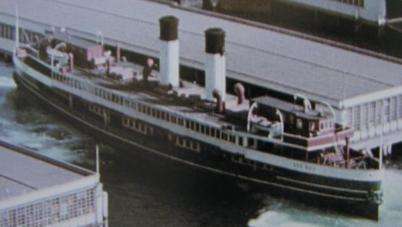 |
| The Bellubera still smoldering from the fire in 1936 | The Dee Why ferry at Circular Quay |
On Wednesday 16 May 1945, a huge storm struck Sydney. The Dee Why broke her moorings at Manly Wharf and slammed into the promenade of the Manly Pool. I have no more details of damage to either the ship or pool.
At 10.05 pm on Christmas Night 1946, heavy fog caused the Dee Why to lose her way and she ran aground on rocks off Obelisk Beach opposite the Heads. The damage was considerable, with one rudder torn off, the prop and hull damaged and part of the keel buckled. I have some suspicions about what caused this incident given when it occurred (who has experienced fog in Sydney in December?!)!
During the Court of Marine Inquiry into the grounding on Christmas Day 1946 which appears to have started on Monday 10 February 1947, it was reported that Sydney Edward Kennedy, the skipper of the Dee Why, was to do a trip to Manly at night under the supervision of Judge Studdert so that Kennedy could read the compass. He had stated that his eye sight was "fair but not of the very best". The same night, a test was done of the compass and of six readings, two were incorrect.
On Wednesday 12 February 1947, the Court found that the course set and checked by the master (skipper) was not made good. No blame was attached to the master or the engineer. It could not be ascertained if Captain Kennedy steered incorrectly or if there was a problem due to the compass.
Just after noon on Sunday 26 October 1947, the SS Curl Curl (the identical sistership of the Dee Why), broke down off Bradleys Head on the way to Circular Quay from Manly. The Dee Why pulled alongside the Curl Curl and took all her passengers off.
On the night of 16 August 1949, passengers of the Dee Why heard shouts from the water. The ferry stopped and rescued a Navy stoker who had fallen off the Bellubera 15 minutes earlier.
 | 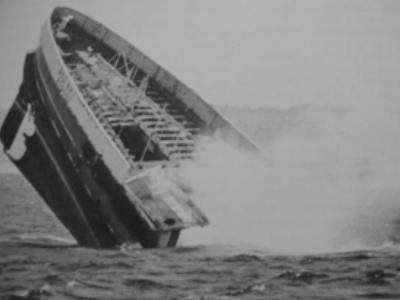 |
| SS Dee Why under full head of steam | The Dee Why is about to disappear |
The Dee Why ran aground once more during its long career, ironically (as I will explain later) after an incident with the tug Himma. Off [?] Point near the Bridge, the two collided and the Dee Why ran aground. Similar damage to the other time she ran aground put her out of service for some time. A funny story about this incident was that a woman was in the toilet when they collided and she was locked inside. An axe was needed to smash through the door to free her. A few other times the Dee Why hit the wharf a bit hard causing a small amount of damage.
Two engineers died on duty on the Dee Why from heart attacks, but apart from the 1939 death, no other fatalities are known to have occurred on her.
In July 1951, the Dee Why and another Manly Ferry the Balgowlah were used to produce gas for the North Shore when the gas company's boilers broke down. At that time, the Dee Why was doing 6658 trips to and from Manly each year but by 1960 it was only doing 2734. The more expensive steam powered ships (the North Head, Baragoola and Bellubera were now diesel-electric) were about to come to the end of their life. In 1960, the Curl Curl was withdrawn and for the last few years the Dee Why was used only as a relief vessel.
Withdrawn from service in July 1968, the Dee Why was sold to Stride Brothers for scrapping. They presumably salvaged the engines, props, interior fittings and other bits of use. After this, she sat around the Harbour for another eight years until on 25 May 1976 two tugs pulled her out of Rozelle Bay and down the Harbour. At 9.15 the sea-cocks were opened and 45 minutes later, the Dee Why's bow (although she was double-ended, there was a bow and stern) suddenly dived and the stern rose up out of the water as she slid to her resting place off Long Reef.
Today, the Dee Why is part of the Long Reef Wreck Site which was originally planned as an artificial reef. It also contains her former combatant, the Himma but there is a remarkable lack of fish on the wrecks compared to the southern wrecks of SS Tuggerah and Undola. The Dee Why lies on a sandy bottom of about 48 metres 4.25 kilometres off Narrabeen Beach. Sitting upright and with her bow facing east and stern to the west, the once proud ferry is but a mere shell of its original beauty. Stripped of her superstructure, the ferry when sunk consisted only of the hull, main and promenade decks and the boilers and some machinery.
 |
A satellite photograph of the coast north east of Long Reef showing the location of the scuttled wrecks
The SS Dee Why is clearly identified |
Due to its large size, the Dee Why is very easy to find, but you can sometimes accidentally hook onto the wreck of the Meggol (ex-HMS Wexford and HMAS Doomba) which is only about 20 metres from the Dee Why's starboard near the eastern end. A GPS Reading 33° 42.9385' S 151° 20.8352' E (using WGS84 as daatum - if you use any other datum, you will need to convert the reading - see my GPS Page for more details) will put you near the wreck and then use the attached marks. You must drop your anchor right on the wreck as it will not grab if it lands on the sand.
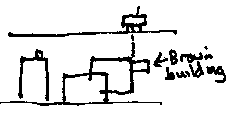 |  |
| Western Mark | North-western Mark |
The top level of the wreck used to be about 40 metres but it is now 43 metres or so (see comments later) and reaches to 46 metres inside the hull. Features of the wreck include the massive bows (two of course, as it is double-ended), the rudders (one on the sand), the propeller shaft, both inside and outside the wreck. There are toilets at the bow (eastern end) and there are many holds to explore.
While the engine has been removed, the four enormous boilers are still in great condition and you can swim between them very easily. Of interest is the fact that the boilers are not in the centre of the ship as you might initially expect. As there was only one engine, the boilers and engine were set so as to balance each other out. Photographs show that the twin funnels were actually located aft of the centre and the boilers are just rear of the centre-line.
Although the Dee Why is now 80 years old, the ship was in relatively good condition until 1997. On my earlier dives here the ship hull was basically still fully intact with only a few holes in the stern area (western end). The ferry still had the promenade deck supports and floor beams in place although the promenade timber decking had been removed before she was scuttled. You could swim along the main deck, especially along the outside passageway. You could also get inside the main cabin area in the space between the main and promenade decks. As well, you could explore the area below the main deck level at either end of the ferry.
As I indicated above, in 1997 (I am not sure when), the wreck suffered a great deal of damage. I have been told that it was caused by a ship dragging an anchor through it but I cannot believe that a big vessel would anchor in the vicinity of the Long Reef Wreck Site as it is well marked on all charts of the area. Personally, I think it was probably caused by normal erosion and possibly some heightened seas.
Today the bow section of the Dee Why (the eastern end) has fallen over to the port (north) and the main deck in this area has collapsed inwards. The promenade deck (or at least its supports and beams) has totally disappeared along the whole length of the the wreck. Whereas the sand around the wreck used to be totally void of wreckage, there are now bits of metal nearly all the way along the wreck on both sides. The western (stern) section has wreckage all over the place on the sand as the promenade deck has collapsed out on both sides. However, this section is still relatively intact (see the photograph above).
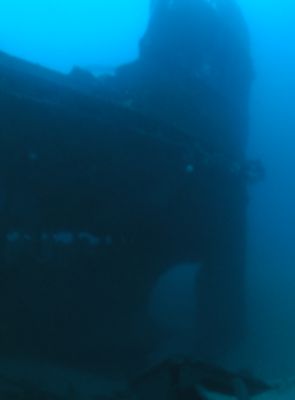 | 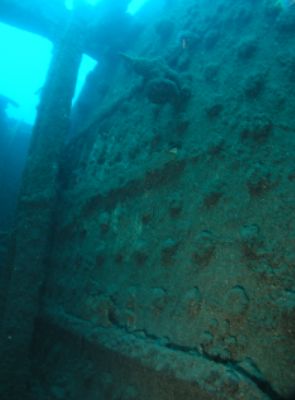 |
The stern of the Dee Why
Compare this to the photo of the ferry sinking above | One of the Dee Why's boilers |
You can still drop down into the lower deck area and explore the boilers as well as some smaller compartments and the driveshaft alley. Amidships to the southern side you can, in good visibility (say 15 metres or better) see the bow of the wreck of the Meggol. You can easily swim over to it if you can see it. In March 2004 there was a rope running between the two wrecks.
On 18 October 2003 I dived the wreck and had a very nice dive. The dive got much more interesting once we ascended. As soon as I reached the six metre mark, I saw what I thought were two dolphins (we had seen some before the dive). I saw out to take a photo and then realised that they were sharks, quite large ones. I turned around to tell the others and saw more. A quick swim back to the anchor and I noticed even more. Hell, there are a lot! I swim out towards a couple I can see and count six, a quick turn back and I see at least four more in one group and then a couple more. There are at least 12, perhaps more. These are black whalers or dusky sharks (whalers) and potentially dangerous. I have 17 minutes of deco to do so I am not real happy about this. They hang around for all this time, disappearing once for a minute or two and only leave when I am almost clear. Luckily, they just swim around us, keeping about 10 metres away for most of the time, although they do come closer (perhaps 3 to 4 metres) at times. A very exhilarating dive!
Despite the recent degradation of the Dee Why, this is a nice dive (I formerly would have called it a great dive) and worth a few return visits (formerly many). Of course, due to its depth, it is only for trained and experienced deep divers.
References:
| 
 v6.00.307 © 2003-2005
v6.00.307 © 2003-2005